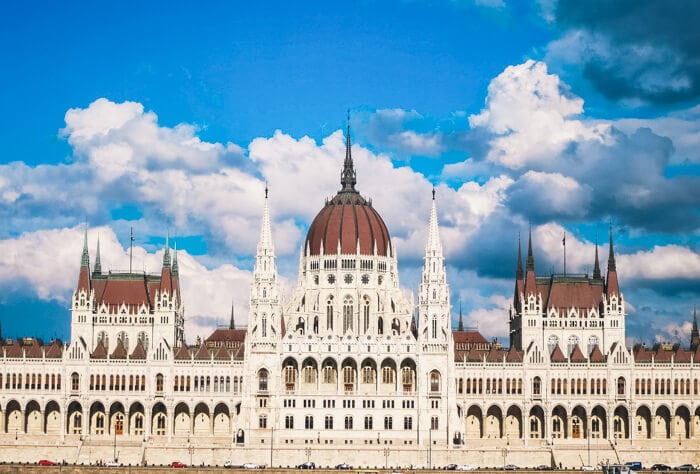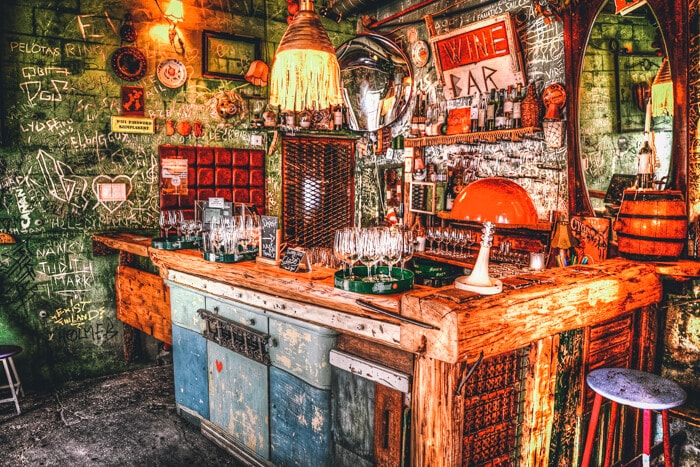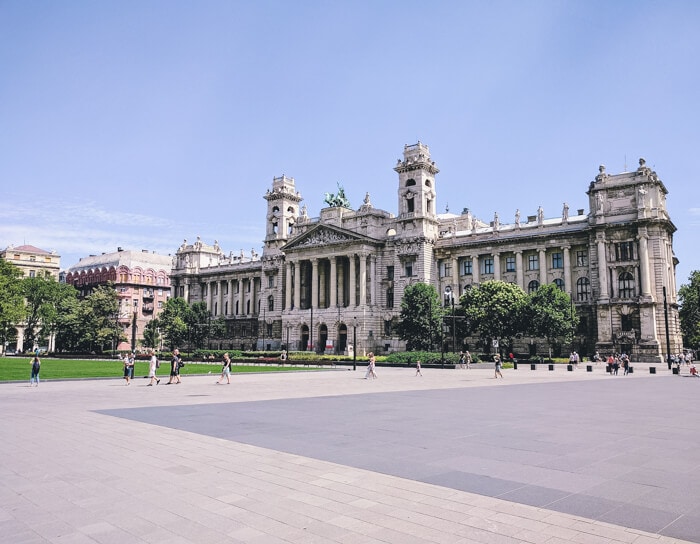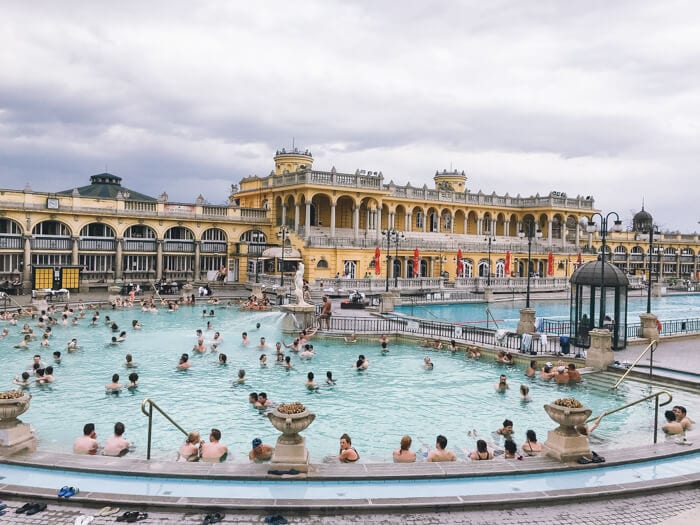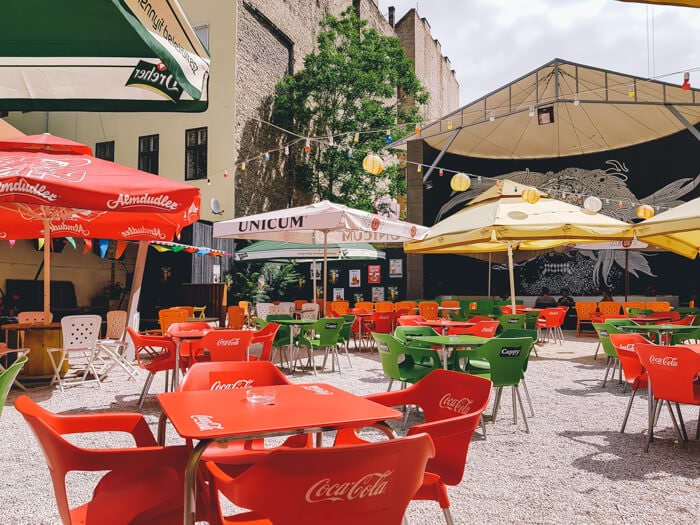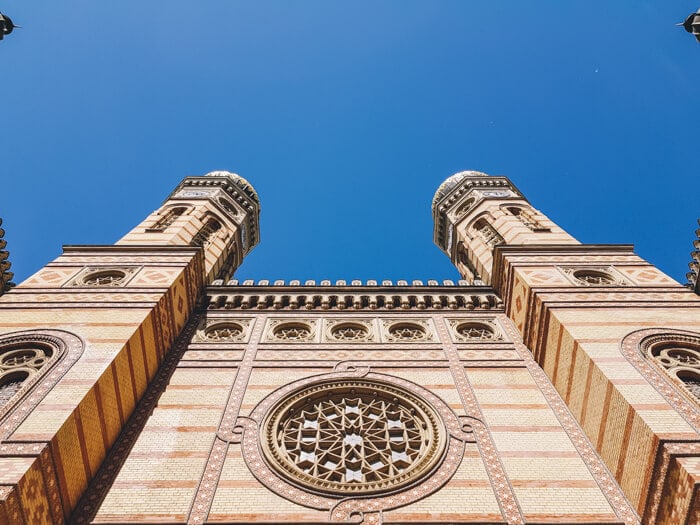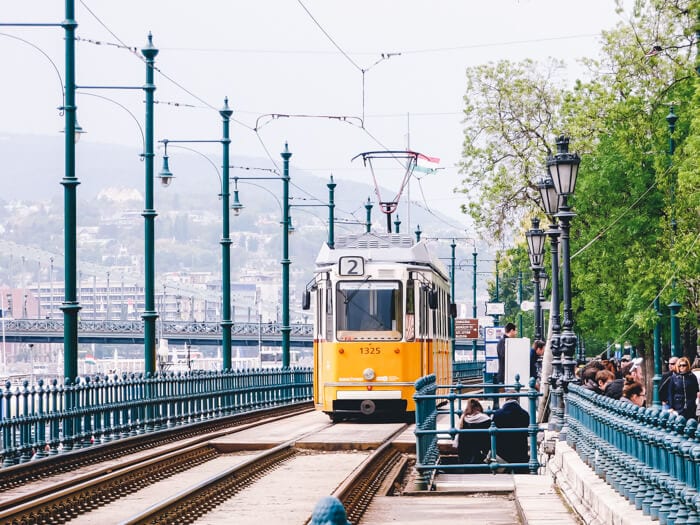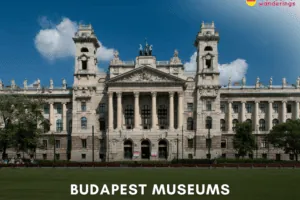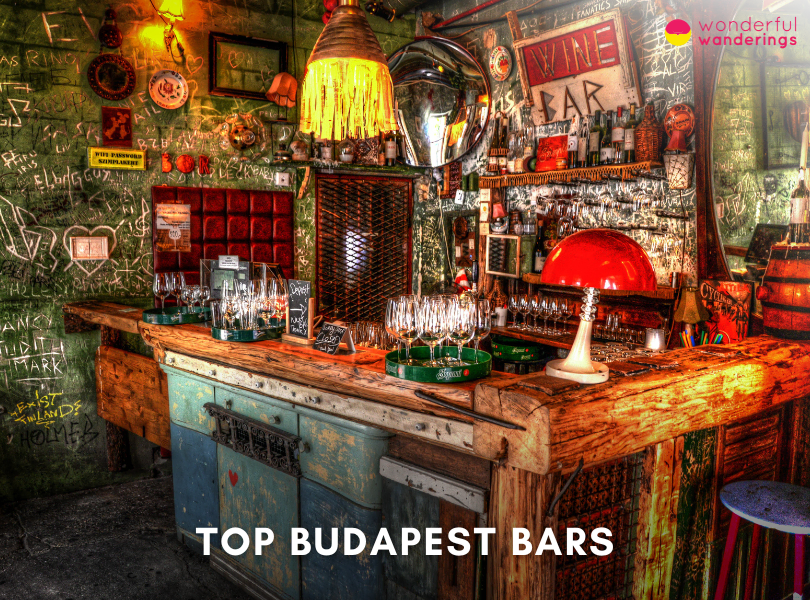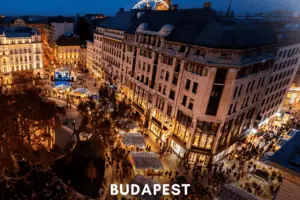If you’re wondering if Budapest is worth visiting, the answer is definitely yes. Budapest, the capital of Hungary should be on your list. Is is often called the “Pearl of the Danube”, is a city that offers a unique blend of history, culture, and beauty. The city is also known for its thermal baths, like the famous Széchenyi Baths, where visitors can relax and unwind. Budapest is a good place to visit, whether visitors are interested in exploring history, enjoying a relaxing spa day, or experiencing the the nightlife.
Find below the 10 reasons why Budapest is worth visiting.
- The architecture. Budapest’s architecture spans various styles from Baroque to Art Nouveau, with ornate churches, imposing buildings, and iconic landmarks like the Chain Bridge exemplifying the city’s long, rich history.
- The ruin bars. Ruin bars are funky, eclectic bars set up in abandoned buildings, packed with quirky decor and furniture; they offer a unique nightlife experience, with Szimpla Kert being the trendsetter.
- The many museums. Budapest has nearly 100 museums and there is something for everyone – art, history, science, and more, from the grandiose Museum of Fine Arts to quirky ones like the Pinball Museum.
- The thermal baths. The thermal baths are dating back 2000 years, like the stunning Szechenyi, offer health benefits and lavish settings to enjoy the city’s abundance of natural hot springs.
- The Sziget festival. For one week every August, Obuda Island hosts Sziget, one of Europe’s biggest music festivals, featuring diverse genres and entertainment alongside humanitarian campaigns.
- The hidden courtyards. Tucked away off the streets, Budapest’s hidden courtyards wow visitors with their majestic arches, stained glass, and cozy atmosphere, like the bars and Sunday market of Gozsdu Courtyard.
- The Jewish heritage. Home to one of Europe’s largest Jewish populations, Budapest’s Jewish Quarter houses the Dohány Street Synagogue, the Holocaust Memorial Center, and other relics of a once thriving community.
- The street art. Budapest’s District VII flaunts colorful street art and murals with social messages, like “The Refugee Girl,” that add vibrant flair to the neighborhood’s derelict buildings.
- The food and drink prices. Budapest is offering a very affordable vacation abroad and impresses visitors with low prices for dining, like €3 entrees, and cheap transportation thanks to an efficient metro system.
- The ease of getting around. Most key attractions are walkable, but Budapest also provides great public transit options like trams, ferries along the Danube, the metro, and buses.
1. The architecture
If you are an architecture lover, the capital of Hungary will have you giddy with excitement. Budapest’s long history can be literally seen in the architectural styles of its breathtaking buildings.
The Baroque style can be noticed in many facades, especially in the beautiful churches with their imposing domes and the extravagant interiors. It is one of the most widely spread forms of architecture in Budapest and two of the most outstanding examples are the Church of St. Anna in Batthyhány Square and the Royal Palace which are a must-visit for anyone.
Although there aren’t that many original Gothic-style buildings left in Budapest, you can still admire this very old style of architecture by visiting the Matthias Church in the Castle District.
The elegant Renaissance and Neo-Renaissance style can be seen when visiting the imposing Budapest Opera House, the Hungarian Academy of Science or St. Stephen’s Basilica.
Other architectural styles that stand out are Classicism and Neoclassicism. One of the most iconic examples is the Chain Bridge, but the Hungarian National Museum, the Lutheran Church and the Basilica in Esztergom are also well worth a visit.
Other important styles that can be seen in Budapest are Art Nouveau (the Museum of Applied Arts stands out with its green tile roof), Socialist Classicism or ‘Stalinist architecture (can be noticed in the outer edges of the city where the concrete apartment blocks can be found), the Romantic style (the Great Synagogue and the Budapest Western Railway Station are great examples), Ottoman architecture and you can even find Roman ruins.
2. The ruin bars
When it comes to entertainment and nightlife, Budapest’s ruin bars are a unique concept that has to be experienced. As the name suggests, the ruin bars are literally bars that have been set up in old, abandoned buildings in the old Jewish quarter.
Even though this might sound a little depressing, these bars are actually the exact opposite. They are charming places, full of personality, where hip artists make their mark with funky, eye-catching decorations. Even the furniture is quirky, gathered from here and there to complete the bohemian feel of the place.
All the bars have their own style and depending on how much time you have, it’s worth visiting a few of them to compare. However, if you are short on time, be sure to have a drink in the original ruin bar, the one that started the trend back in 2001: Szimpla Kert.
It is still one of the biggest and most popular of the ruin bars with themed rooms, a spacious courtyard and even an old Trabant car (talking of unexpected, quirky things).
3. The many museums
Considering Hungary’s tumultuous history, it’s no surprise that Budapest has almost 100 museums which will help you have a better understanding of the country’s culture. There is something for everybody.
Art lovers shouldn’t miss the Museum of Fine Arts, the Hungarian National Gallery or the Ludwig Museum of Contemporary Art. History buffs will thoroughly enjoy the Budapest History Museum and the Hungarian National Museum. Visitors who are interested in the Holocaust will find the Holocaust Memorial Center, the Dohany Street Synagogue and Hungarian Jewish Museum extremely fascinating.
There is literally a museum for every taste, including some unusual ones like the House of Terrors (a very popular museum dedicated to the fascist and communist eras), the Museum of Hungarian Agriculture (anyone interested in plowing techniques and crops is welcome), or the Hospital in the Rock (as the name suggests, this used to be a treatment center in a natural cave).
Another quirky museum to visit, is the Pinball Museum. It showcases the evolution of pinball from the 19th century to the present day. Best of all: you get to try some machines!
Besides the all-year-round museum exhibits, there are interesting temporary exhibitions so make sure to check those out as well.
4. The thermal baths
One of the nicknames that Budapest has is the “City of Baths”. The reason for this is that the capital sits on roughly 120 hot springs. People have been enjoying the benefits of these thermal waters as early as the 1st century AD.
Each of the settlers here has put their mark on the baths. The first to use them were the Romans and you can still see the excavated ruins of one of the public baths called Thermae Maiores. The next to enjoy the hot springs were the Ottomans and amazingly, some of the baths that they built are still functional today. At the beginning of the 20th century, the Austro-Hungarian Empire built some of the most extravagant bathhouses.
Budapest’s thermal baths are famous all over the world and people flock to them not only for the balneotherapy benefits but also for the stunning architecture and the myriad of fun activities.
There is a total of nine thermal baths today in Budapest each with its own distinct character. The biggest and the most popular is Szechenyi Bath (built in 1913) with its 18 pools open all year-round. Gellért Bath is another lavish thermal bath built in the art nouveau style in 1918.
If you prefer less pretentious baths, Lukács Bath, Király Bath, and Veli Bej Bath are much more discreet and less crowded.
5. The Sziget festival
If you happen to be in Budapest in the month of August, then the Sziget festival is an experience that can’t be missed. For one week, Obuda-island is transformed into one of Europe’s most popular multi-genre music festivals.
With big names from blues, jazz, rock, pop, dubstep, hip hop, reggae and more, Sziget attracts a significant number of visitors from all over the world (in 2018 it was reported that 565.000 people attended the festival).
The Sziget festival is famous not only for the quality music but also for the multitude of other activities such as a theatre and dance stage, a cinema, circus shows, culture and art activities, spirituality and sport. In addition to all of this, there are some pretty cool restaurants, bars and cafes to be discovered.
But the festival is not only about entertainment. Two years ago, Sziget started a campaign called “Love Revolution” which focuses on human rights, takes a stance against discrimination of any kind and promotes sustainability. With so many visitors, the festival’s campaign to change the world for the good is truly commendable.
6. The hidden courtyards
We have already established that Budapest has some spectacular buildings filled with history and architectural splendor. What is less known is that many of these buildings hide astonishing courtyards with majestic arches, imposing columns, stained glass windows that are works of art in themselves and beautiful ivy plants to compliment it all.
Unfortunately, not all courtyards are open to the public, however, there are plenty of secret gardens that are accessible to visitors where they will fully enjoy diverse activities or just a simple coffee surrounded by beauty.
Probably the most famous of them all is Gozsdu Courtyard, at the heart of the Jewish quarter, which is comprised of several interconnecting courtyards full of bars, pubs, restaurants, and even a Sunday market. But if you prefer more intimate places, Röser Courtyard in District V no. 22, Paloma Courtyard also in District V no. 14-16 or the few hidden courtyards along Múzeum Körút, are a great way to spend some quiet, relaxing time.
7. The Jewish heritage
Budapest has one of the largest Jewish communities in Middle and Eastern Europe. So, naturally, there is a wealth of religious, historical and artistic heritage to be found in the Jewish Quarter, which is situated in the City Center.
In recent years, this neighborhood had seen rapid change and modernization, however, there are still many things to be discovered that will give you a glimpse into the once flourishing Jewish life.
Within the Jewish Quarter, you will find Europe’s largest synagogue, the Dohany Street Synagogue. Within the synagogue, you will also see the Jewish Museum, the Jewish Cemetery, Raoul Wallenberg Memorial Park and more.
Another must-visit is the Holocaust Memorial Center, dedicated to the atrocities that the Jewish community had to endure during World War II.
There are more synagogues that are well worth visiting and many more interesting attractions like the Mikvah, a ritual Jewish bathhouse, the only one of its kind in Budapest.
8. The street art
Every major city around the world has street art but Budapest takes it to a different level. If you take a walk through District VII you will find stunning and vibrant murals that often have socio political messages.
Considering the fact that the seventh District has quite a few derelict buildings, the colorful street art, masterfully created by both established and novice graffiti masters and artists, brings the whole neighborhood to life.
There are a few incredibly beautiful murals, like “The Refugee Girl” (showing a Pakistani girl with a haunting gaze), the Rubik’s Cube (the popular toy was invented by a Hungarian architect), the Green Grocer (a lifelike depiction of the original façade of the building) or the Playground (another astonishingly realistic mural) and many more just waiting to be discovered.
It’s like walking through an outdoor museum of modern art.
9. The food and drink prices
Budapest is a fairly cheap city to visit and if you don’t eat at Michelin star restaurants every day and sleep in luxury hotels, then you can have a vacation that won’t break the bank.
Hungary’s currency is the Forint (FT, HUF) and it is strongly recommended that you pay for all your expenses with the local currency as it comes cheaper than with euros.
Having said that, a three-course meal for two people at a mid-range restaurant will cost between €30 and €50, so the cost of eating out in Budapet is pretty low.
A pint of beer can be anywhere between €1.30 and €6, an espresso around €1.30, a bottle of soft drink (of 0.33l) about €1, a small bottle of water between €0.70 and €1.50.
Of course, it depends on the area. The touristic areas have higher prices as opposed to the less popular areas.
Street food can be a cheap option, considering that you will find them everywhere selling a variety of food, from the popular Hungarian kyurtoshkalac (€1.50-€2.50), various sandwiches (€0.80- €2), strudel (€2) to roasted meat (pork, chicken, beef), potatoes, peppers and pickles. Generally speaking, you can have a hearty meal for no more than €2.50.
Of course, there are also the local taverns where you can have an authentic Hungarian culinary experience. Prices range from €1.70 for a meatball soup to around €9 for a large meat dish (Hungarians really do have big portions). Drinks are anywhere between €1.50-€2 for a cup of herbal tea to €3 for a decent glass of wine.
So, as you can see, food and drink are not expensive at all in Budapest, especially if you avoid eating and drinking in the tourist traps.
10. The ease of getting around
Probably the best way of discovering Budapest is by walking, especially since most of the main attractions like bars, museums, thermal baths are within walking distance.
However, if walking is not your cup of tea, you should know that Budapest has a very efficient public transport system. The quickest method is the metro which will take you anywhere you need to go in Budapest.
If you prefer the surface, there are a few options: the tram (or yellow streetcars), trolleybuses and buses. There is also a Danube river ferry service which is especially nice for visitors as they get to see the city from the Danube river.
If you want to go to nearby towns, there is an efficient suburban railway system (HEV).
To go on any of the public transport, you will need a valid ticket. These can be bought at metro entrances, newsstands, ticket machines or kiosks. As a visitor, you will probably be better off buying a travel pass as you won’t have to deal with buying and validating a ticket every time you board.
You should know that public transport runs till 11 PM but there are some night buses. Also ordering a taxi is another option for late hours.
A ready-to-use itinerary and best things to do guide for Budapest
If all of the reasons above have convinced you that Budapest is worth visiting, my Budapest things to do guide will help you plan your own trip there. It includes a full program of things to do as well as where to stay, how to get to Budapest, and how to get around in the city.
Go check it out!
I hope this post answered the question of whether Budapest is worth visiting for you and that it answered “Yes!”
PIN FOR LATER


